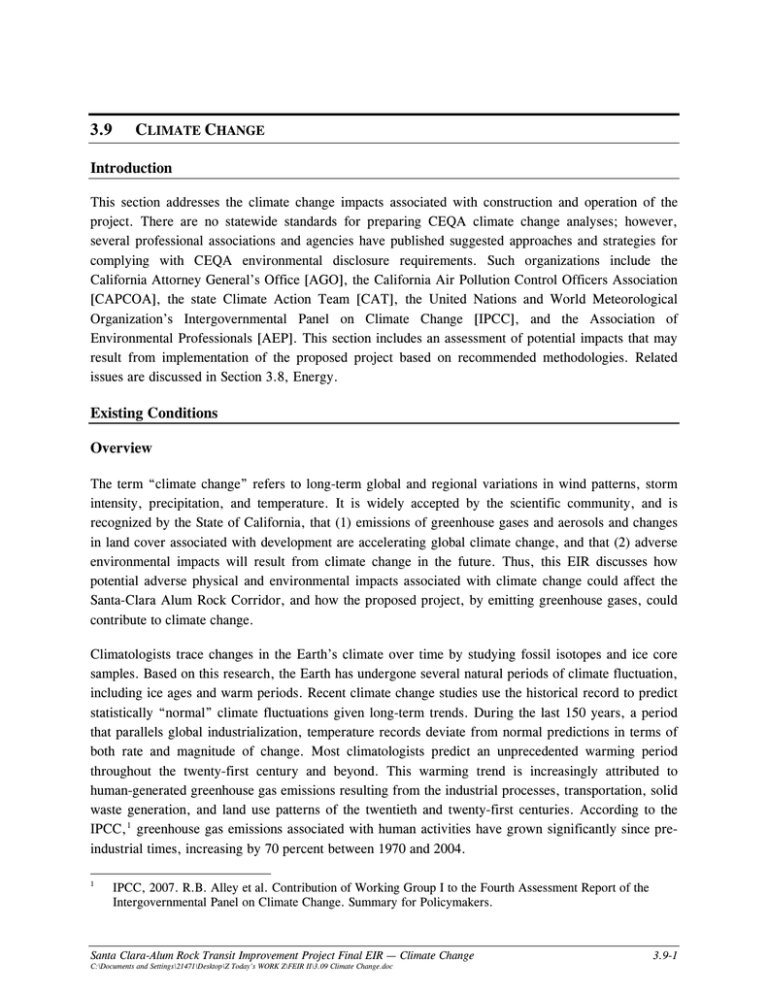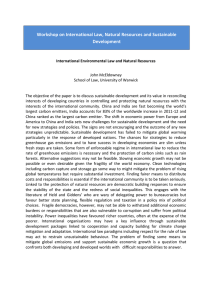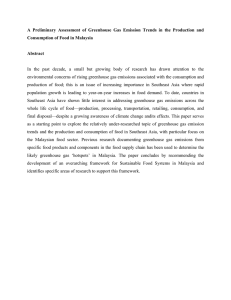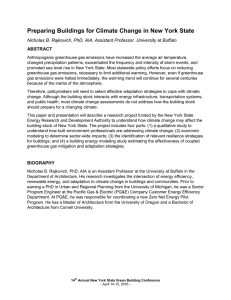Introduction Existing Conditions Overview
advertisement

3.9 CLIMATE CHANGE Introduction This section addresses the climate change impacts associated with construction and operation of the project. There are no statewide standards for preparing CEQA climate change analyses; however, several professional associations and agencies have published suggested approaches and strategies for complying with CEQA environmental disclosure requirements. Such organizations include the California Attorney General’s Office [AGO], the California Air Pollution Control Officers Association [CAPCOA], the state Climate Action Team [CAT], the United Nations and World Meteorological Organization’s Intergovernmental Panel on Climate Change [IPCC], and the Association of Environmental Professionals [AEP]. This section includes an assessment of potential impacts that may result from implementation of the proposed project based on recommended methodologies. Related issues are discussed in Section 3.8, Energy. Existing Conditions Overview The term “climate change” refers to long-term global and regional variations in wind patterns, storm intensity, precipitation, and temperature. It is widely accepted by the scientific community, and is recognized by the State of California, that (1) emissions of greenhouse gases and aerosols and changes in land cover associated with development are accelerating global climate change, and that (2) adverse environmental impacts will result from climate change in the future. Thus, this EIR discusses how potential adverse physical and environmental impacts associated with climate change could affect the Santa-Clara Alum Rock Corridor, and how the proposed project, by emitting greenhouse gases, could contribute to climate change. Climatologists trace changes in the Earth’s climate over time by studying fossil isotopes and ice core samples. Based on this research, the Earth has undergone several natural periods of climate fluctuation, including ice ages and warm periods. Recent climate change studies use the historical record to predict statistically “normal” climate fluctuations given long-term trends. During the last 150 years, a period that parallels global industrialization, temperature records deviate from normal predictions in terms of both rate and magnitude of change. Most climatologists predict an unprecedented warming period throughout the twenty-first century and beyond. This warming trend is increasingly attributed to human-generated greenhouse gas emissions resulting from the industrial processes, transportation, solid waste generation, and land use patterns of the twentieth and twenty-first centuries. According to the IPCC, 1 greenhouse gas emissions associated with human activities have grown significantly since preindustrial times, increasing by 70 percent between 1970 and 2004. 1 IPCC, 2007. R.B. Alley et al. Contribution of Working Group I to the Fourth Assessment Report of the Intergovernmental Panel on Climate Change. Summary for Policymakers. Santa Clara-Alum Rock Transit Improvement Project Final EIR — Climate Change C:\Documents and Settings\21471\Desktop\Z Today's WORK Z\FEIR II\3.09 Climate Change.doc 3.9-1 The IPCC has constructed several trajectories of the greenhouse gas emission reductions needed to stabilize global temperatures and minimize climate change impacts. The IPCC predicted that the range of global mean temperature change from 1990 to 2100, given six scenarios, could range from 1.1 degrees Celsius (°C) to 6.4°C. The IPCC projects an increase of global greenhouse gas emissions by 25 to 90 percent between 2000 and 2030, depending on the reduction thresholds, mitigation measures, and alternative fuel development pursued around the world during this period. It should be noted that regardless of the analytical methodology used and the level of greenhouse gas reductions that are assumed, global average temperature and sea level are expected to rise under all scenarios modeled by the IPCC. 2 Climate change is considered by the IPCC to be an irreversible effect; its impacts can be minimized but not avoided altogether. Greenhouse Gas Emissions Associated with Development Environmental and Physical Characteristics. Gases that trap heat in the atmosphere are called greenhouse gases because they transform the light of the sun into heat, similar to the glass walls of a greenhouse. Common greenhouse gases include water vapor, carbon dioxide, methane, nitrous oxides, chlorofluorocarbons, hydrofluorocarbons, perfluorocarbons, sulfur hexafluoride, ozone, and aerosols. Without the natural heat trapping effect of greenhouse gases, the earth’s surface would be about 34°C cooler. 3 However, it is believed that emissions from human activities, such as electricity production and vehicle use, have elevated the concentration of these gases in the atmosphere beyond naturally occurring concentrations. As a result of human activities, global atmospheric concentrations of carbon dioxide, methane and nitrous oxide have increased markedly since 1750 and now far exceed preindustrial concentrations. This has been confirmed through studying from ice core samples spanning many thousands of years. Climate change results from a combination of radiative forcings and feedbacks. Radiative forcing is defined as the difference between the radiation energy entering the Earth’s atmosphere and the radiation energy leaving the atmosphere. Greenhouse gases allow solar radiation to penetrate the Earth’s atmosphere but slow the release of atmospheric heat. A feedback is an internal process that amplifies or dampens the climate’s response to a specific forcing. For example, the heat trapped by the atmosphere may cause temperatures to rise or may alter wind and weather patterns. A gas or aerosol’s global warming potential is the “cumulative radiative forcing effects of a gas over a specified time horizon resulting from the emission of a unit mass of gas relative to a reference gas”; 4 in other words, it is defined as the gas’ propensity to trap heat in the atmosphere on a molecular level. Individual greenhouse gases have varying global warming potentials and atmospheric lifetimes (see Table 3.9-1). Total emissions are often estimated using the “carbon dioxide equivalent” method, which normalizes various greenhouse gas emissions to a consistent metric and allows comparison of global 2 3 4 Ibid. Climate Action Team (CAT). 2007. Climate Action Team Proposed Early Actions to Mitigate Climate Change in California. http://www.climatechange.ca.gov/climate_action_team/reports/index.html. U.S. Environmental Protection Agency, 2007. Atmosphere Changes. http://www.epa.gov/climatechange/science/recentac.html#radiative Santa Clara-Alum Rock Transit Improvement Project Final EIR — Climate Change C:\Documents and Settings\21471\Desktop\Z Today's WORK Z\FEIR II\3.09 Climate Change.doc 3.9-2 warming potential. For this method, carbon dioxide is used as a reference gas, and is considered to have a global warming potential of one. By comparison, methane’s global warming potential is 21, as methane has a greater global warming effect than carbon dioxide on a molecule to molecule basis. 5 One teragram (Tg) (equal to one million metric tons) of carbon dioxide equivalent (Tg CO2e) is the mass emissions of an individual greenhouse gas multiplied by its global warming potential. Table 3.9-1 Global Warming Potentials and Atmospheric Lifetimes of Select Greenhouse Gases Gas Carbon Dioxide Methane Nitrous Oxide HFC-23 HFC-134a HFC-152a PFC: Tetrafluoromethane (CF4) PFC: Hexafluoroethane (C2F6) Sulfur Hexafluoride (SF6) Atmospheric Lifetime (years) Global Warming Potential (100 year time horizon) 50–200 12 ±3 120 264 14.6 1.5 50,000 10,000 3,200 1 21 310 11,700 1,300 140 6,500 9,200 23,900 Source: EPA 2006b Notes: HFC –hydrofluorocarbons PFC – perfluorocarbons Generally, the major sources of greenhouse gases generated by transportation sources include carbon dioxide (CO2), nitrous oxide (N2O), and methane (CH4). These gases are described below. • 5 6 7 Carbon dioxide (CO2) is an odorless, colorless gas, which has both natural and anthropogenic sources. Natural sources include decomposition of dead organic matter; respiration of bacteria, plants, animals, and fungus; evaporation from oceans; and volcanic outgassing. Anthropogenic sources of carbon dioxide are from burning coal, oil, natural gas, and wood. Concentrations of carbon dioxide were 379 parts per million (ppm) in 2005, which is an increase of 1.4 ppm per year since 1960. 6 CO2 is the most common greenhouse gas in California, constituting approximately 84 percent of all greenhouse gas emissions. 7 CO2 emissions in California are mainly associated with in-state fossil fuel combustion and with fossil fuel combustion in out-ofstate power plants supplying electricity to California. Other activities that produce CO2 emissions include mineral production, waste combustion, and land use changes that reduce vegetation. Ibid. Ibid, IPCC, 2007. R.B. Alley et al. California Energy Commission, 2006. Inventory of California Greenhouse Gas Emissions and Sinks: 1990 to 2004. Staff Final Report. Santa Clara-Alum Rock Transit Improvement Project Final EIR — Climate Change C:\Documents and Settings\21471\Desktop\Z Today's WORK Z\FEIR II\3.09 Climate Change.doc 3.9-3 • Nitrous oxide (N2O), also known as laughing gas, is a colorless greenhouse gas. Nitrous oxide is produced by microbial processes in soil and water, including those reactions that occur in fertilizer containing nitrogen. In addition to agricultural sources, some industrial processes (fossil fuel-fired power plants, nylon production, nitric acid production, and vehicle emissions) also contribute to its atmospheric load. • Methane (CH4) is a flammable gas and is the main component of natural gas. When one molecule of methane is burned in the presence of oxygen, one molecule of carbon dioxide and two molecules of water are released. A natural source of methane is from the anaerobic decay of organic matter. Geological deposits, known as natural gas fields, also contain methane, which is extracted for fuel. Other sources are from vehicle emissions, landfills, fermentation of manure, and cattle. Other gases that contribute to the greenhouse effect include ozone, 8 chlorofluorocarbons (CFCs), hydrofluorocarbons (HFCs), perfluorocarbons (PFCs), sulfur hexafluoride (SF6) and aerosols. These gases are generally associated with residential and/or industrial uses. Transportation projects do not generate significant levels of these gases. Sources of Greenhouse Gases Associated with Transportation Systems. California’s transportation sector is heavily dependent upon oil, with petroleum-based fuels currently supplying 96 percent of California’s transportation energy needs. 9 By percentage, the transportation sector is the largest contributor to greenhouse gas emissions in California. The nearly 26 million registered vehicles operating in California produce between 27 to 41 percent of the state’s greenhouse gas emissions. 10 Within the transportation sector, light vehicles (i.e., cars, light trucks, and motorcycles) account for about 60 percent of the petroleum-based energy consumption. Transportation systems that emphasize single-occupancy vehicle use (i.e. freeway systems) also generate large quantities of emissions. By contrast, mass transit systems reduce the energy consumed for transport and result in relatively low emissions. In addition to consuming petroleum fuels, some mass transit systems consume electricity or alternative fuels. Electricity generation is California’s second largest source of greenhouse gas emissions. While some emissions are generated out of state, California greenhouse gas inventories consider all greenhouse gas emissions released during generation of the electricity used in California (even emissions released out of state) to be California emissions. Out-of-state electricity generation accounts for a large portion of the electricity generation emissions because out-of-state fuel sources have higher 8 9 10 Ozone is a greenhouse gas; however, unlike other greenhouse gases, ozone in the troposphere is relatively short-lived. It is difficult to make an accurate determination of the contribution of ozone precursors (nitrogen oxides and volatile organic compounds) to global climate change. California Environmental Protection Agency, 2004. Technical Support Document for Staff Proposal Regarding Reduction of Greenhouse Gas Emissions from Motor Vehicles Climate Change Overview. California Energy Commission, 2003. Transportation Fuels, Technologies, and Infrastructure Assessment Report (subsidiary volume to the 2003 Integrated Energy Policy Report). California Energy Commission, 2007. 2007 Integrated Energy Policy Report. http://www.energy.ca.gov/2007publications/CEC-100-2007-008/CEC-100-2007-008-ctf.pdf; California Energy Santa Clara-Alum Rock Transit Improvement Project Final EIR — Climate Change C:\Documents and Settings\21471\Desktop\Z Today's WORK Z\FEIR II\3.09 Climate Change.doc 3.9-4 carbon intensity than in-state sources. Industrial electricity use, which includes the transportation sector, accounts for about 20.5 percent of California’s emissions. 11 Federal and State Greenhouse Gas Inventories. In 2004, total worldwide greenhouse gas emissions were estimated to be 20,135 Tg CO2e, excluding emissions/removals from land cover change and forestry. In 2004, greenhouse gas emissions in the U.S. were 7,074.4 Tg CO2e or 35 percent of worldwide totals. 12 Global emissions rose from 2004 to 2005, increasing by 0.8 percent. In 2005, total U.S. greenhouse gas emissions were 7,260.4 Tg CO2e, a 16.3 percent increase from 1990 emissions. 13 California is the second largest greenhouse gas emitter in the United States and the sixteenth largest emitter in the world. In 2004, California produced 492 Tg CO2e, 14 which is approximately seven percent of U.S. emissions and 2.44 percent of global emissions. CO2 produced from fossil fuel combustion represents 81 percent of California’s total greenhouse gas emissions. 15 The remaining greenhouse gas emissions, by percent of California’s total carbon dioxide equivalent emissions, include 2.8 percent from non-combustion sources of CO2, 5.7 percent from methane, 6.8 percent from nitrous oxide, and 2.9 percent from other high global warming potential gases. Alterations to Land Cover Sinks (i.e. greenhouse gas removal processes) play an important role in the greenhouse gas inventory. Forests, wetlands, certain agricultural crops and other carbon-storing land uses are considered sinks, reservoirs that remove and store atmospheric CO2. Sinks help to regulate temperature fluctuations associated with the greenhouse effect. Land cover conversions may result in the production of additional greenhouse gas emissions, but they can also lessen the earth’s ability to offset such emissions by reducing its existing carbon storage capacity. However, urban development often involves redevelopment and not conversion of undeveloped parcels, which does not result in the conversion of carbon sinks. There are no significant carbon sinks along the Santa Clara-Alum Rock Corridor alignment. Regulatory Setting While climate change has been a concern since at least 1988, as evidenced by the establishment of the United Nations and World Meteorological Organization’s IPCC, the efforts devoted to greenhouse gas emissions reduction and climate change research and policy have increased dramatically in recent years. Executive Order S-3-05. On June 1, 2005, Governor Arnold Schwarzenegger signed Executive Order S-3-05. The goal of this Executive Order is to reduce California’s greenhouse gas emissions to: 1) 2000 levels by the year 2010, 2) 1990 levels by the year 2020, and 3) 80 percent below 1990 levels 11 12 13 14 15 Ibid, California Energy Commission, 2006. Ibid. Ibid. Ibid. Ibid. Santa Clara-Alum Rock Transit Improvement Project Final EIR — Climate Change C:\Documents and Settings\21471\Desktop\Z Today's WORK Z\FEIR II\3.09 Climate Change.doc 3.9-5 by the year 2050. The California Climate Action Team’s (CAT) 2006 Report to the Governor contains recommendations and strategies to help ensure the targets in Executive Order S-3-05 are met. Assembly Bill 32. In 2006, the goals of Executive Order S-3-05 were further reinforced when the California State Legislature adopted Assembly Bill 32 (AB 32), the Global Warming Solutions Act of 2006. Greenhouse gases, as defined under AB 32, include carbon dioxide, methane, nitrous oxide, hydrofluorocarbons, perfluorocarbons, and sulfur hexafluoride. AB 32 requires the California Air Resources Board (CARB), the State agency charged with regulating statewide air quality, to create a plan, which includes market mechanisms, and implement rules to achieve “real, quantifiable, costeffective reductions of greenhouse gases”. AB 32 sets the same greenhouse gas emissions reduction goal for 2020 as Executive Order S-3-05 (reduction of emissions to the 1990 level). On or before June 30, 2007, CARB was required to publish a list of discrete early action greenhouse gas emission reduction measures that can be implemented by 2010. The law further requires that such measures achieve the maximum technologically feasible and cost effective reductions in greenhouse gases from sources or categories of sources to achieve the statewide greenhouse gas emissions limit for 2020. Executive Order S-20-06. Executive Order S-20-06 directs state agencies to begin implementing AB 32, including the recommendations made by in the CAT and CARB reports. Senate Bill 97. The provisions of Senate Bill 97, enacted in August 2007 as part of the State Budget negotiations, direct the Office of Planning and Research (OPR) to propose CEQA Guidelines advising lead agencies how to mitigate the impacts of greenhouse gas emissions. OPR has been directed to promulgate such guidelines by July 2009, and the Resources Agency has been directed to adopt such guidelines by January 2010. At this time, however, there are no CEQA Guidelines or other formal direction from regulatory agencies regarding the analysis of greenhouse gas emissions. The OPR guidelines were not available as of the date of preparation of this document and were unavailable for use in this analysis. Climate change and greenhouse gas reduction is also a concern at the federal level; however, at this time, no legislation or regulations have been enacted to regulate greenhouse gas emissions associated with public transit systems. Impact Assessment and Mitigation Measures Approach and Methodology This analysis considers the climate change effects of the proposed project as described in Section 2, Project Description, of this document. As discussed in the introduction to this section, there are no State sanctioned methodologies for assessing a project’s impacts with respect to climate change; however, several professional associations and agencies have published suggested approaches for complying with CEQA requirements. This document utilizes approaches from the following professional white papers: Mitigation Measures and Global Warming Resources (AGO, 2007), Alternative Approaches to Analyzing Greenhouse Gas Emissions and Global Climate Change in CEQA Documents (AEP, 2007), CEQA and Climate Change (CAPCOA, 2008), Climate Action Team Santa Clara-Alum Rock Transit Improvement Project Final EIR — Climate Change C:\Documents and Settings\21471\Desktop\Z Today's WORK Z\FEIR II\3.09 Climate Change.doc 3.9-6 Proposed Early Actions to Mitigate Climate Change in California (CAT, 2007); and Climate Change 2007: Fourth Assessment Report (IPCC, 2007). Significance criteria are derived based on the CAPCOA and AEP reports, the description of predicted climate change impacts is drawn from the IPCC report and from U.S. Environmental Protection Agency (EPA) predictions, and the discussion of emissions reductions strategies is drawn from the AGO and CAT reports. The environmental analysis breaks the discussion of climate changes impacts into two topics: (1) a discussion of how the proposed project would contribute to cumulative climate change via release of greenhouse gas emissions, and (2) a discussion of how climate change’s environmental effects could affect the proposed project over time. Standards of Significance There are no widely agreed upon thresholds of significance for greenhouse gas emissions, and no state or applicable regional regulatory agency has formally adopted or issued guidance regarding the analysis of greenhouse gas emissions in EIRs. 16 Section 15064.7 of the CEQA Guidelines encourages public agencies to develop and publish their own thresholds of significance for CEQA analyses until the OPR publicizes statewide CEQA thresholds in 2009. CAPCOA’s 2008 report, CEQA and Climate Change, suggests a number of strategies for determining whether a project’s emissions would be cumulatively considerable. While CAPCOA suggests numerous approaches for setting quantitative thresholds, it also proposes that state and local governments may wish to consider exceptions for locally desirable projects, projects that make a positive contribution to reducing greenhouse gas emissions or that result in other public benefits (e.g. public transportation projects or affordable housing). Such projects would be included on a “Green List”—a list of preferred projects considered exempt from CEQA climate change emissions thresholds. This document discusses the proposed project as a potential Green List project, describing the features of the Phase 1 – BRT portion and the Phase 2 – Single Car LRT portion of the proposed project that would stabilize, or even contribute to a regional reduction, in emissions. This EIR does not employ significance thresholds for the analysis of climate change’s possible longterm environmental effects on the implementation of project activities because the predicted long-term environmental effects of climate change are speculative and vary widely between models. A qualitative discussion is provided based on the environmental effects predicted by the IPCC and the U.S. EPA. Environmental Analysis In order to determine climate change impacts due to construction and operation of the proposed project, a level of significance is determined and reported. Conclusions of significance are defined as follows: significant (S), potentially significant (PS), less than significant (LTS), no impact (NI), and beneficial (B). If the mitigation measures would not diminish potentially significant or significant impacts to a 16 Association of Environmental Professionals (AEP). 2007. Alternative Approaches to Analyzing Greenhouse Gas Emissions and Global Climate Change in CEQA Documents. http://www.califaep.org/userdocuments/File/AEP_Global_Climate_Change_June_29_Final.pdf. Santa Clara-Alum Rock Transit Improvement Project Final EIR — Climate Change C:\Documents and Settings\21471\Desktop\Z Today's WORK Z\FEIR II\3.09 Climate Change.doc 3.9-7 less-than-significant level, the impacts are classified as “significant and unavoidable (SU).” For this section, CC refers to Climate Change. For the purposes of this analysis, the proposed project includes the implementation of BRT and Single Car LRT in the Santa Clara-Alum Rock Corridor in two phases. Phase 1 includes the implementation of BRT service and Phase 2 includes the implementation of Single Car LRT service. Potential climate change impacts associated with Phase 1 and Phase 2 of the proposed project, including project options, would be largely similar. Therefore, the analyses for the two project phases are discussed together. Areas in which the effects of the two phases differ are detailed within the discussion of each significance threshold. Potential impacts associated with the extension of transit services in the Capitol Expressway Corridor were analyzed in the Capitol Expressway Light Rail Final Supplemental Environmental Impact Report (FSEIR) dated January 2007, which is incorporated herein by reference. Potential impacts of the proposed project not analyzed in the Capitol Expressway Light Rail FSEIR are described below, as necessary. This analysis discusses how greenhouse gases emitted during construction and operation of the proposed project would contribute to global climate change. This section also discusses how the climate change impacts predicted by the IPCC would be expected to impact the Santa Clara-Alum Rock Corridor. Impacts of the Santa Clara-Alum Rock Transit Improvement Project on Climate Change. The greenhouse gas emissions from an individual project, even a very large development project, would not individually generate sufficient greenhouse gas emissions to measurably influence global climate change. 17 However, while an individual project’s contributions to climate change would be less than significant, greenhouse gas contributions from multiple projects combine to form cumulatively considerable emissions, resulting in a significant adverse impact. Thus, while a project-level analysis of global climate change would not link any significant impacts to the proposed project, further cumulative analysis is required to determine whether the proposed project would qualify as a Green List project—a project that would have a positive or neutral effect on greenhouse gas emissions— according to the CAPCOA guidelines. Although current land uses along the proposed alignment emit greenhouse gases, the proposed project would consume more energy than existing on-site uses and would therefore produce a net increase in emissions relative to on-site uses. However, it is inappropriate to use emissions from current on-site uses as the emissions baseline because the project would offset emissions in a much larger regional area by providing an alternative to single occupancy vehicle travel. Between 11,000 and 15,000 riders, some of whom may be currently traveling via automobile, would be able to take advantage of the proposed public transportation option following project implementation. VTA’s 2005-2006 On-Board Passenger Survey, Final Report, October 2006 included the following question for transit riders; “If 17 Ibid. Santa Clara-Alum Rock Transit Improvement Project Final EIR — Climate Change C:\Documents and Settings\21471\Desktop\Z Today's WORK Z\FEIR II\3.09 Climate Change.doc 3.9-8 transit didn’t exist, how would you have made this trip?” A total of 21 percent replied that they would drive alone. Therefore, approximately one in five transit riders would generate greenhouse gases through use of their own vehicles if transit did not exist. Public transit is more energy efficient than multiple automobile trips and would result in a lower level of greenhouse gas emissions. 18 Therefore, there is reason to conclude that, on a regional basis, the project would not increase, and could even result in a net decrease, in greenhouse gas emissions by increasing the efficiency of the regional transportation system. A large percentage of the emissions associated with transportation result from vehicles travelling at low speeds during congestion on freeways and arterials. In addition to offsetting emissions directly by providing a more efficient means of transporting large numbers of people, the proposed project could indirectly reduce greenhouse gas emissions by offsetting demand for roadway capacity and contributing to improvements in roadway congestion within the Downtown East Valley Study Area. However, regional reductions in congestion associated with the proposed project have not been modeled and are speculative at this time. The proposed project would use reduced-emissions fuels as an alternative to petroleum fuels where feasible. Although the Phase 1 – BRT portion of the proposed project would initially use petroleumbased diesel fuels, it is anticipated that hydrogen fuel would be substituted for some of the diesel fuel as hydrogen fuels become more commercially available. VTA is also studying the feasibility of using “zero-emission buses" (ZEB's) and has purchased three buses that utilize hydrogen-gas-fueled fuel cells for a study project. The articulated light rail cars used for the Phase 2 – Single Car LRT portion of the proposed project would be powered by electricity, which, although a significant statewide source of greenhouse gas emissions, results in lower greenhouse gas emissions per unit of energy consumed. 19 Liquid hydrogen, when substituted for petroleum fuels on a unit-by-unit basis, results in a 19.9 percent reduction in greenhouse gas emissions; gaseous hydrogen results in a 41.1 percent reduction; and electricity results in a 46.8 percent reduction. 20 These emissions account not only for carbon dioxide, but also methane and nitrous oxide. The actual emissions of the proposed project would depend on the amount of fuel needed to power the vehicles, which consequently depends on the model and weight of vehicles used. However, the proposed project would be expected to incorporate reduced-emission alternative fuels to the extent possible. Based on the above considerations, the proposed project would be expected to have a positive impact on regional greenhouse gas emissions. Therefore, the project appears to qualify as a Green List project under the general guidelines outlined by CAPCOA. In addition to having a net zero effect on emissions, the project could also be considered to be a beneficial public use per the Green List specifications. CAPCOA states that the “extension of transit lines to currently developed but underserved communities” may also be considered for inclusion in a Green List. As discussed in 18 19 20 Poudenx, Pascal and Walter Merida, 2007. Energy Demand and Greenhouse Gas Emissions from Urban Passenger Transportation Versus Availability of Renewable Energy. Energy. V32, I1, January 2007, pp.1-9. U.S. Environmental Protection Agency, 2007. Greenhouse Gas Impacts of Expanded Renewable and Alternative Fuels Use. http://www.epa.gov/OMS/renewablefuels/420f07035.htm Ibid. Santa Clara-Alum Rock Transit Improvement Project Final EIR — Climate Change C:\Documents and Settings\21471\Desktop\Z Today's WORK Z\FEIR II\3.09 Climate Change.doc 3.9-9 Section 2, Purpose and Need, the proposed project would meet demand for public transportation facilities within the Downtown East Valley Study Area, an area where many residents are transitdependent and have incomes below the median. The proposed project is also consistent with the recommendations of the AGO, whose suggested climate change mitigation measures promote public transit alternatives to automotive travel. 21 The impacts of the proposed project for the Santa ClaraAlum Rock Corridor would be less than significant with respect to greenhouse gas emissions, and the project is considered a Green List project, exempt from further CEQA review. Impacts of Climate Change on the Santa Clara-Alum Rock Transit Improvement Project. In addition to contributing to climate change impact, the proposed project would be subject to environmental impacts as the result of climate change. The following constitutes a list of climate change effects modeled in recent studies that could affect the Santa Clara-Alum Rock Corridor. A general description of each effect is given, followed by a discussion of how each effect would apply to the proposed project. Although this analysis makes a good-faith effort to consider likely climate change effects, it is not possible to prepare an exhaustive list of all of the possible adverse impacts that could occur. The type and degree of the impacts that climate change will have on humans and the environment are still largely speculative. Moreover, the effects of climate change are exceptionally difficult to predict at the local scale or with any temporal certainty. 21 22 23 24 • Sea level rise. Climate change is expected to raise sea levels by up to four feet. 22 While the Corridor is at an inland location, a sea level rise of one meter (approximately three feet) could inundate large portions of the South Bay. However, effects related to sea level rise are speculative at this time. If determined to be a significant threat, protective measures such as levees would likely be installed by regional and local governments to protect urbanized areas. • Natural disasters. Climate change could result in increased flooding and weather-related disasters. 23 Because the Santa Clara-Alum Rock Corridor is within the lower San Francisco Bay, it would be shielded from intense coastal storms and would not be expected to sustain significant damage. However, the frequency of large floods on rivers and streams could also increase, which could affect the portion of the alignment near Coyote Creek, Silver Creek or the Lower Guadalupe River. A portion of the project site is located in the 100-year flood zone, which could be flooded more frequently if the frequency of large storms increased. However, as stated in Section 3.12, Hydrology, the Santa Clara-Alum Rock Corridor does not include habitable structures and would not impede flood flows; thus, flood-related impacts would be less than significant even under an intensified flooding scenario. • Air quality. Climate change would compound negative air quality impacts in the San Francisco Bay Area Air Basin, resulting in respiratory health impacts. 24 However, this would be a Attorney General’s Office, 2007. Mitigation Measures and Global Warming Resources. http://ag.ca.gov/globalwarming/pdf/GW_mitigation_measures.pdf Ibid, IPCC, 2007. R.B. Alley et al. Ibid. California Environmental Protection Agency, no date. AB 1493 (Pavley) Briefing Package Global Warming and Greenhouse Gas Emissions from Motor Vehicles. Santa Clara-Alum Rock Transit Improvement Project Final EIR — Climate Change C:\Documents and Settings\21471\Desktop\Z Today's WORK Z\FEIR II\3.09 Climate Change.doc 3.9-10 regional, not a project-specific effect. Moreover, the Santa Clara-Alum Rock Corridor’s impacts on air quality were found to be less than significant in Section 3.3, Air Quality. Other predicted physical and environmental impacts associated with climate change include: heat waves, alteration of disease vectors, biome shifts, impacts on agriculture and the food supply, reduced reliability in the water supply, and strain on the existing capacity of sanitation and water-treatment facilities. While these issues are a concern for society at large, none of these impacts would have a disproportionate effect on the Santa Clara-Alum Rock Corridor or implementation of proposed projectrelated activities. Santa Clara-Alum Rock Transit Improvement Project Final EIR — Climate Change C:\Documents and Settings\21471\Desktop\Z Today's WORK Z\FEIR II\3.09 Climate Change.doc 3.9-11






